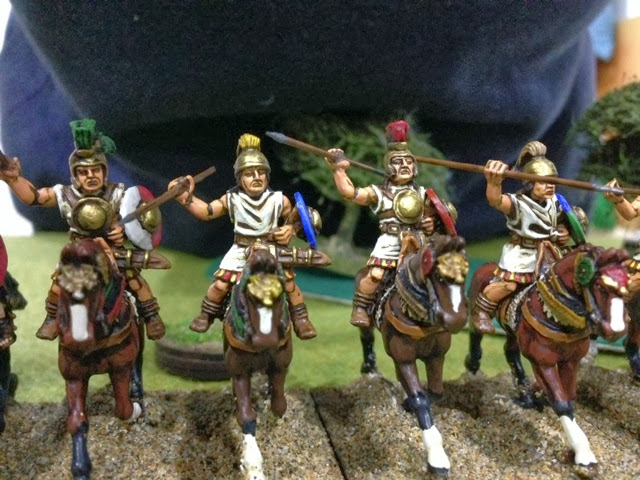I set up a 6x5 table with figures representing Syracusans and Spanish from the mid 3rd century BCE.
Here is a view of the Syracusans
This a view of the Spanish line.
I started by taking the standard troop types from the book.
I treated Hoplites as ordinary Shieldwall
I classified one unit of Hoplites as Companions (representing the tyrant and his elite mercenary guards).
I decided to try out some Gauls? I used the special rule for fanatics to cover these.
Greek style cavalry were treated as ordinary riders. Greek style light cavalry were treated as mounted Skirmishers with javelins.
I made up a standard 32 point army using 6 units of Hoplites, two of Gauls and one each of heavy and light cavalry.
I decided to avoid skirmishing infantry for this first attempt.
For the Spanish I took one unit of mounted Companions to represent the King and his body guard.
I took a unit of mounted nobles to represent Spanish medium cavalry (this made them a little better than the Syracusan cavalry).
The Scutarii were treated as warriors. I decided to waive the rule that makes them impetuous and gave them the hurled weapons special rule to represent their heavy throwing spears. This is a departure from the rules as written where hurled weapons is reserved for Shieldwall troops.
For the Caetrati I treated them as warriors with the javelins special rule.
I made up my Spanish army from one unit of mounted companions, one of noble cavalry, one of mounted Skirmishers, two of Caetrati and three of Scutarii.
I gave each unit a frontage of about 160 mm and used 6 inches to represent a base width for measuring.
In my game the Spanish noble cavalry and the Syracusans medium horse quickly came to grips. this fight went on for a while. I think that this melee went on for too long, 3 or 4 rounds of drawn combat.
The Gallic fanatics rushed across the field and hit the Spanish mounted companions and a unit of Caetrati. The Gauls were destroyed in a single move. This was dramatic. The fanatics look interesting but they are very fragile.
On the other flank the opposing mounted Skirmishers came within range and traded ineffective javelin throws for a number of moves. After a while I got bored and charged one unit into the other. they destroyed each other in one round of fighting.
In the centre the Hoplites moved forward and eventually charged the Spanish line. The battle went to and fro for 3 moves. By this point (move 7) the Syracusans army was looking weak. The cavalry had gone, the Gallic nutters were history, losing one unit of Hoplites would trigger morale tests.
This happened next move and the Syracusans collapsed (ordinary troops have morale 7, you have to throw the morale value or lower to survive).
Spanish victory.
My thoughts.
First off; it worked. An enjoyable game fought solo in about an hour.
I forgot about interrupting enemy moves in order to get the jump on charges. This would have made a difference to the game.
What would I change.
Look at the Gauls! Make them noble warriors rather than fanatics.
Add a rule to break off drawn cavalry combats. maybe after two turns of drawing.
Look at using the rider stats for skirmishing cavalry but still have them move as Skirmishers. They would last a bit longer.
Here are a few shots of the figures.

















1 comment:
I hadn't seen this before. I'm a big fan of Dux Bellorum, and have recently been left feeling underwhelmed by Men of Bronze. I've just ordered a back issue of the magazine to check this out!
Post a Comment